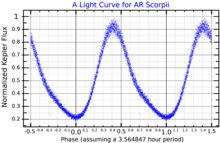Artist’s impression of AR Scorpii. | |
| Observation data Epoch J2000 Equinox J2000 | |
|---|---|
| Constellation | Scorpius |
| Right ascension | 16 21 47.28 |
| Declination | −22° 53′ 10.3″ |
| Characteristics | |
| Apparent magnitude (G) | 13.6 - 16.9 |
| White dwarf | |
| Evolutionary stage | White dwarf |
| Red dwarf | |
| Evolutionary stage | Main sequence |
| Spectral type | M5 |
| Astrometry | |
| Proper motion (μ) | RA: 9.707 mas/yr Dec.: −51.469 mas/yr |
| Parallax (π) | 8.4918 ± 0.0408 mas |
| Distance | 384 ± 2 ly (117.8 ± 0.6 pc) |
| Details | |
| White dwarf | |
| Mass | 0.8 M☉ |
| Radius | 0.01 R☉ |
| Rotation | 1.95 minutes |
| Red dwarf | |
| Mass | 0.28 - 0.45 M☉ |
| Other designations | |
| AR Sco, 2MASS J16214728-2253102 | |
| Database references | |
| SIMBAD | data |
AR Scorpii (AR Sco) is a binary pulsar that consists of a white dwarf and a red dwarf. It is located close to the ecliptic plane in the constellation Scorpius. Parallax measurements made by Gaia put the system at a distance of about 380 light-years (120 parsecs).

AR Scorpii is the first "white dwarf-pulsar" to be discovered. Its unusual nature was first noticed by amateur astronomers. The 3.56-hour period in AR Scorpii's light curve caused it to be misclassified as a Delta Scuti variable, but in 2016, this period was found to be the binary orbital period. In addition, the system shows very strong optical, ultraviolet, and radio pulsations originating from the red dwarf with a period of just 1.97 minutes, which is a beat period from the orbital rotation and the white dwarf spin. These pulsations occur when a relativistic beam from the white dwarf sweeps across the red dwarf, which then reprocesses the beam into the observed electromagnetic energy. Although the white dwarf shows evidence of accretion in the past, at present it is not accreting significantly, and the system is powered by the spin-down of the white dwarf. The white dwarf's rotation will slow down on a timescale of 10 years. It has a radius of about 7×10 km, about the same size as Earth.
See also
- AE Aquarii - the first discovered white dwarf pulsar.
- eRASSU J191213.9−441044 - another white dwarf pulsar
- Pulsar-like white dwarfs
References
- ^ Cutri, Roc M.; Skrutskie, Michael F.; Van Dyk, Schuyler D.; Beichman, Charles A.; Carpenter, John M.; Chester, Thomas; Cambresy, Laurent; Evans, Tracey E.; Fowler, John W.; Gizis, John E.; Howard, Elizabeth V.; Huchra, John P.; Jarrett, Thomas H.; Kopan, Eugene L.; Kirkpatrick, J. Davy; Light, Robert M.; Marsh, Kenneth A.; McCallon, Howard L.; Schneider, Stephen E.; Stiening, Rae; Sykes, Matthew J.; Weinberg, Martin D.; Wheaton, William A.; Wheelock, Sherry L.; Zacarias, N. (2003). "VizieR Online Data Catalog: 2MASS All-Sky Catalog of Point Sources (Cutri+ 2003)". CDS/ADC Collection of Electronic Catalogues. 2246: II/246. Bibcode:2003yCat.2246....0C.
- "AR Scorpii". International Variable Star Index. AAVSO. Retrieved 2023-03-13.
- ^ Marsh, T. R.; et al. (2016). "A radio-pulsing white dwarf binary star". Nature. 537 (7620): 374–377. arXiv:1607.08265. Bibcode:2016Natur.537..374M. doi:10.1038/nature18620. PMID 27462808. S2CID 4451512.
- ^ Brown, A. G. A.; et al. (Gaia collaboration) (August 2018). "Gaia Data Release 2: Summary of the contents and survey properties". Astronomy & Astrophysics. 616. A1. arXiv:1804.09365. Bibcode:2018A&A...616A...1G. doi:10.1051/0004-6361/201833051. Gaia DR2 record for this source at VizieR.
- ^ Singh, K. K.; Meintjes, P. J.; Yadav, K. K. (2021). "Properties of white dwarf in the binary system AR Scorpii and its observed features". Modern Physics Letters A. 36 (13). arXiv:2103.11602. Bibcode:2021MPLA...3650096S. doi:10.1142/S0217732321500966. S2CID 232307204.
- "MAST: Barbara A. Mikulski Archive for Space Telescopes". Space Telescope Science Institute. Retrieved 8 December 2021.
- ^ Buckley, D. A. H.; Meintjes, P. J.; Potter, S. B.; Marsh, T. R.; Gänsicke, B. T. (2017-01-23). "Polarimetric evidence of a white dwarf pulsar in the binary system AR Scorpii". Nature Astronomy. 1 (2): 0029. arXiv:1612.03185. Bibcode:2017NatAs...1E..29B. doi:10.1038/s41550-016-0029. S2CID 15683792.
- Hambsch, Franz-Josef (15 August 2016). "Amateurs Help Discover Pulsing White Dwarf". Sky and Telescope.
- Pelisoli, Ingrid; Marsh, T. R.; Buckley, David A. H.; Heywood, I.; Potter, Stephen B.; Schwope, Axel; Brink, Jaco; Standke, Annie; Woudt, P. A.; Parsons, S. G.; Green, M. J.; Kepler, S. O.; Munday, James; Romero, A. D.; Breedt, E. (2023-06-15). "A 5.3-min-period pulsing white dwarf in a binary detected from radio to X-rays". Nature Astronomy. 7 (8): 931–942. arXiv:2306.09272. Bibcode:2023NatAs...7..931P. doi:10.1038/s41550-023-01995-x. ISSN 2397-3366. S2CID 259164753.
- Gamillo, Elizabeth (2023-06-21). "Second-ever elusive white dwarf pulsar spotted | Astronomy.com". Astronomy Magazine. Retrieved 2023-07-15.
- Lewis, Evan (23 June 2023). "The Only Known White Dwarf Pulsar Just Got a Little Sibling". Astrobites.